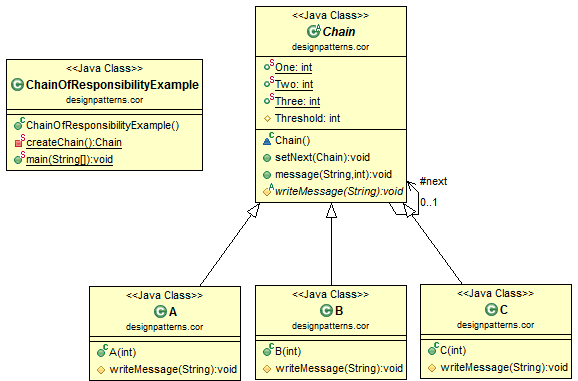Java设计模式:责任链模式
29 Sep 2014注:本文为译文,原文出处java-design-patterns-in-stories
责任链模式的主要思想是构建一个处理单元的链条, 如果满足某一阀值则每一个单元都将处理此请求. 由于创建了一个链, 如果一个单元满足阀值, 那么它的下一个单元就将被尝试, 以此类推. 每个请求都将沿着链被处理.
责任链模式类图

责任链模式Java代码
package designpatterns.cor;
abstract class Chain {
public static int One = 1;
public static int Two = 2;
public static int Three = 3;
protected int Threshold;
protected Chain next;
public void setNext(Chain chain) {
next = chain;
}
public void message(String msg, int priority) {
//if the priority is less than Threshold it is handled
if (priority <= Threshold) {
writeMessage(msg);
}
if (next != null) {
next.message(msg, priority);
}
}
abstract protected void writeMessage(String msg);
}
class A extends Chain {
public A(int threshold) {
this.Threshold = threshold;
}
protected void writeMessage(String msg) {
System.out.println("A: " + msg);
}
}
class B extends Chain {
public B(int threshold) {
this.Threshold = threshold;
}
protected void writeMessage(String msg) {
System.out.println("B: " + msg);
}
}
class C extends Chain {
public C(int threshold) {
this.Threshold = threshold;
}
protected void writeMessage(String msg) {
System.out.println("C: " + msg);
}
}
public class ChainOfResponsibilityExample {
private static Chain createChain() {
// Build the chain of responsibility
Chain chain1 = new A(Chain.Three);
Chain chain2 = new B(Chain.Two);
chain1.setNext(chain2);
Chain chain3 = new C(Chain.One);
chain2.setNext(chain3);
return chain1;
}
public static void main(String[] args) {
Chain chain = createChain();
chain.message("level 3", Chain.Three);
chain.message("level 2", Chain.Two);
chain.message("level 1", Chain.One);
}
}
这个例子中, level 1遍历了责任链中的所有单元.
A: level 3
A: level 2
B: level 2
A: level 1
B: level 1
C: level 1
译者补充
JDK中的责任链模式
JDK在异常捕获机制中使用了责任链模式, 当方法出现异常时, 首先会被当前方法的catch代码块, 如果当前方法不能处理这个异常, 那么可以继续抛出异常, 异常就会被调用当前方法的方法中的catch块捕获, 以此类推.
同样, 大家熟知的Servlet中的Filter也基于责任链模式, 创建自定义的过滤器需要实现Filter接口的doFilter(ServletRequest request, ServletResponse response, FilterChain chain)方法, 在方法实现中可以自由控制是否继续下一个过滤器的处理, 可以通过调用chain.doFilter(request, response);把请求与响应发送给下一个过滤器, 从而达到对责任链的遍历.